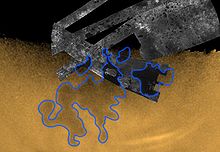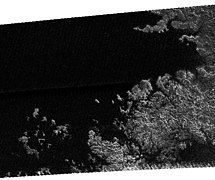크라켄마레
Kraken Mare | |
| 피쳐 타입 | 마레 |
|---|---|
| 좌표 | 68°N 310°W/68°N 310°W좌표: 68°N 310°W / 68°N 310W / |
| 직경 | 1,170 km[note 1] |
| 에포니메 | 크라켄 |
Kraken Mare / krkrːkən mmɑre/는 토성의 위성 타이탄 표면에서 알려진 가장 큰 액체체이다.그것은 2006년 우주 탐사선 카시니에 의해 발견되었고 2008년 전설적인 바다 [1]괴물인 크라켄의 이름을 따왔다.그것은 지구의 카스피해보다 약간 더 넓은 지역을 덮고 있다.
묘사
50만2 [2]킬로미터에 있는 크라켄 마레는 타이탄에서 가장 큰 액체로 여겨진다.그것은 달의 북극 [1]지역에 있다.탄화수소 바다(주로 액체 메탄)의 상태는 레이더 이미지로 확인되었다.Kraken Mare는 지구의 카스피 해보다 더 큰 것으로 생각된다.경보 발생기로 사용된 카시니 레이더 고도계 데이터를 분석한 결과, 크라켄 마레 본체의 깊이는 최소 100m이며 300m [3]이상일 가능성이 있는 것으로 나타났다.최북단 베이 중 하나(Moray Syns)의 중심 깊이는 85(-18, +28)m이며, 70% 메탄, 16% 질소 및 14% 에탄(이상적 [3]혼합 가정)의 조성과 양립 가능한 액체 내 신호의 감쇠를 나타낸다.크라켄마레 [4]표면에서 1.5cm 높이의 얕은 모세관 파동이 초속 0.7m로 움직이는 것이 포착됐다.
바다에 있는 섬의 이름은 Mayda Insula입니다.Kraken Mare는 타이탄에서 두 번째로 큰 바다인 [5]Ligeia Mare와 수문학적으로 연결되어 있을 수 있다.이 연관성은 리게이아 마레에서 크라켄 마레로 특정 화합물이 유입되기 때문에 바다 조성의 차이로 인해 제안되었다.또한 Kraken Mare는 Ligeia [6]Mare보다 메탄 농도가 낮습니다.
317°W,[7] 67°N의 바다에 있는 좁은 협곡은 지브롤터 해협과 약 17km의 너비로 크기가 비슷하며 공식적으로 셀던 프레툼으로 명명되어 '크라켄의 적혈구'로 불리며 상당한 [8]해류가 있는 곳으로 추정된다.타이탄의 궤도 편심 때문에 크라켄 마레에서 1m의 조류가 발생하여 0.5m/s의 전류를 발생시키고 소용돌이도 [5]발생할 수 있다.다른 계산에서는 조수가 5미터에 [2]이를 것으로 추정한다.
"마법의 섬"으로 알려진 변화하는 지형이 크라켄 마레에서 관찰됩니다.타이탄에서 활성 탄화수소 순환을 나타내는 이러한 특징들은 질소 [9][10]용해로 인해 상승하는 기포일 수 있습니다.
관찰 및 탐색
크라켄 마레는 다른 타이탄 호수들과 함께 카시니호에 의해 처음 발견되었다.2006년 7월 22일 Huygens 우주 탐사선.이는 특히 극지 부근의 특정 어두운 지역이 낮은 레이더 반사율을 가지고 있을 뿐만 아니라 지상 [11]호수와 유사한 형태학적 특징을 가지고 있다는 것을 알아냄으로써 달성되었다.그 이후 많은 관찰 결과들이 이러한 [12][2][13]발견들을 확인시켜주었다.레이더 영상 외에도 카시니 측정기 VIMS(Visible and 적외선 매핑 분광계)가 크라켄마레와 [12]그 주변을 조사했다.
탐사선과 잠수함을 통해 크라켄 마레의 깊이를 탐사하자는 여러 제안과 아이디어가 있었다.그러한 잠수함 중 하나는 NASA의 1단계 연구를 거쳤으며, 잠수함 설계와 [14]설계도를 완성했다.또 다른 제안인 타이탄 마레 탐사선은 크라켄 마레를 2차 표적으로 하여 리게이아 마레 호수를 탐사하는 최종 후보였으나,[15] 화성 착륙선 인사이트가 대신 받아들여졌다.타이탄 마레 탐사선은 또한 진행되지 않은 타이탄 토성 탐사 임무에 포함될 것을 제안받았다.
무인기 드래곤플라이(우주선)의 타이탄으로의 임무는 승인되었지만,[16] 현재 타이탄에 있는 크라켄마레나 다른 호수들을 탐사하는 임무는 없다.
갤러리
「 」를 참조해 주세요.
메모들
- ^ USGS 웹사이트는 크기를 "지름"으로 제공하지만, 실제로는 가장 긴 치수의 길이입니다.
레퍼런스
- ^ a b "Kraken Mare". Gazetteer of Planetary Nomenclature. USGS Astrogeology Science Center. Archived from the original on 2018-08-08. Retrieved 2012-03-16.
- ^ a b c Hayes, Alexander G. (2016-06-29). "The Lakes and Seas of Titan". Annual Review of Earth and Planetary Sciences. 44 (1): 57–83. Bibcode:2016AREPS..44...57H. doi:10.1146/annurev-earth-060115-012247. ISSN 0084-6597. Archived from the original on 2021-01-20. Retrieved 2020-09-14.
- ^ a b Poggiali, V.; Hayes, A. G.; Mastrogiuseppe, M.; Le Gall, A.; Lalich, D.; Gomez-Leal, I.; Lunine, Jonathan I. (2020). "The bathymetry of Moray Sinus at Titan's Kraken Mare". Journal of Geophysical Research: Planets. 125 (12). Bibcode:2020JGRE..12506558P. doi:10.1029/2020JE006558.
- ^ Hand, Eric (December 16, 2014). "Spacecraft spots probable waves on Titan's seas". Science. Archived from the original on 2015-01-04. Retrieved 2015-01-14.
- ^ a b Lorenz, R. D. (2014). The Throat of Kraken : Tidal Dissipation and Mixing Timescales in Titan's Largest Sea (PDF). 45th Lunar and Planetary Science Conference (2014). The Woodlands, Texas. p. 1476. Archived (PDF) from the original on 2016-03-04. Retrieved 2014-06-09.
- ^ Lorenz, Ralph D. (2014). "The flushing of Ligeia: Composition variations across Titan's seas in a simple hydrological model". Geophysical Research Letters. 41 (16): 5764–5770. Bibcode:2014GeoRL..41.5764L. doi:10.1002/2014GL061133. ISSN 1944-8007. S2CID 129370565. Archived from the original on 2022-01-25. Retrieved 2021-04-01.
- ^ "Seldon Fretum". USGS planetary nomenclature page. USGS. Archived from the original on 2015-04-27. Retrieved 2015-05-23.
- ^ Rincon, P. (2014-03-18). "'Waves' detected on Titan moon's lakes". BBC web site. BBC. Archived from the original on 2014-05-31. Retrieved 2014-06-09.
- ^ Farnsworth, Kendra K.; Chevrier, Vincent F.; Steckloff, Jordan K.; Laxton, Dustin; Singh, Sandeep; Soto, Alejandro; Soderblom, Jason M. (2019). "Nitrogen Exsolution and Bubble Formation in Titan's Lakes". Geophysical Research Letters. 46 (23): 13658–13667. Bibcode:2019GeoRL..4613658F. doi:10.1029/2019GL084792. ISSN 1944-8007. S2CID 213542086. Archived from the original on 2020-08-03. Retrieved 2021-04-01.
- ^ Hofgartner, J. D.; Hayes, A. G.; Lunine, Jonathan I.; Zebker, H.; Stiles, B. W.; Sotin, C.; Barnes, J. W.; Turtle, E. P.; Baines, K. H.; Brown, R. H.; Buratti, B. J. (2014). "Transient features in a Titan sea". Nature Geoscience. 7 (7): 493–496. Bibcode:2014NatGe...7..493H. doi:10.1038/ngeo2190. ISSN 1752-0908. Archived from the original on 2021-03-10. Retrieved 2021-04-01.
- ^ Stofan, E. R.; Elachi, C.; Lunine, Jonathan I.; Lorenz, R. D.; Stiles, B.; Mitchell, K. L.; Ostro, S.; Soderblom, L.; Wood, C.; Zebker, H.; Wall, S. (2007). "The lakes of Titan". Nature. 445 (7123): 61–64. Bibcode:2007Natur.445...61S. doi:10.1038/nature05438. ISSN 1476-4687. PMID 17203056. S2CID 4370622. Archived from the original on 2021-03-09. Retrieved 2021-04-01.
- ^ a b Stephan, Katrin; Jaumann, Ralf; Brown, Robert H.; Soderblom, Jason M.; Soderblom, Laurence A.; Barnes, Jason W.; Sotin, Christophe; Griffith, Caitlin A.; Kirk, Randolph L.; Baines, Kevin H.; Buratti, Bonnie J. (2010). "Specular reflection on Titan: Liquids in Kraken Mare". Geophysical Research Letters. 37 (7): n/a. Bibcode:2010GeoRL..37.7104S. doi:10.1029/2009GL042312. ISSN 1944-8007.
- ^ Hayes, A.; Aharonson, O.; Callahan, P.; Elachi, C.; Gim, Y.; Kirk, R.; Lewis, K.; Lopes, R.; Lorenz, R.; Lunine, Jonathan I.; Mitchell, K. (2008). "Hydrocarbon lakes on Titan: Distribution and interaction with a porous regolith". Geophysical Research Letters. 35 (9). Bibcode:2008GeoRL..35.9204H. doi:10.1029/2008GL033409. ISSN 1944-8007.
- ^ Hartwig, J. W.; Colozza, A.; Lorenz, R. D.; Oleson, S.; Landis, G.; Schmitz, P.; Paul, M.; Walsh, J. (2016-03-01). "Exploring the depths of Kraken Mare – Power, thermal analysis, and ballast control for the Saturn Titan submarine". Cryogenics. 2015 Space Cryogenics Workshop, June 24–26, 2015, Phoenix, AZ Hosted by NASA Glenn Research Center, Cleveland, OH, USA. 74: 31–46. Bibcode:2016Cryo...74...31H. doi:10.1016/j.cryogenics.2015.09.009. ISSN 0011-2275. Archived from the original on 2017-05-29. Retrieved 2021-04-01.
- ^ Stofan, E.; Lorenz, R.; Lunine, Jonathan I.; Bierhaus, E. B.; Clark, B.; Mahaffy, P. R.; Ravine, M. (2013). "TiME - The Titan Mare Explorer". 2013 IEEE Aerospace Conference: 211. Bibcode:2013aero.confE.211S. doi:10.1109/AERO.2013.6497165. ISBN 978-1-4673-1813-6. S2CID 17290531. Archived from the original on 2022-01-21. Retrieved 2021-04-01.
- ^ "NASA selects Titan drone for next New Frontiers mission". SpaceNews. 2019-06-28. Archived from the original on 2022-01-25. Retrieved 2021-04-01.







